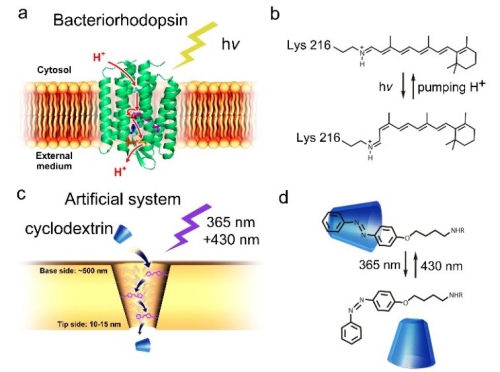In nature, biological machines and motors can selectively transport cargoes across the lipid membranes to efficiently perform various physiological functions via ion channels or ion pumps. It is interesting and challengeable to develop artificial motors and machines of nanodimensions to controllably regulate mass transport in compartmentalized systems.
Recently, a group led by Prof. JIANG Lei at Technical Institute of Physics and Chemistry (TIPC), Chinese Academy of Sciences, has achieved a series of research progresses. Building upon their previous results (J. Am. Chem. Soc. 2018, 140, 4552-4559; J. Am. Chem. Soc. 2018, DOI: 10.1021/jacs.8b10527), researchers reported a system of artificial molecular motors that used light as the energy source to perform transmembrane molecule transport through synthetical nanochannels, which was recently published on Angewandte Chemie International Edition (DOI: 10.1002/anie.201809627). After functionalizing the polymer nanochannels with azobenzene derivatives, these nanomachines exhibit autonomous selective transport behavior over a long distance upon simultaneous irradiation with UV (365 nm) and visible (430 nm) light. The rate of transporting per pore is estimated to be 9.5×106±5.21×105 s-1, which is comparable with most biological ion channels (transporting rate >106 s-1 per pore) and much larger than that of transporter proteins (hundreds of s-1 per pore). During these transportation processes, the hydrophobility, reversible photoreaction, and light-powered rotation–inversion movement of Azo group function as a filter, stirrer, and transporter to selectively move the CD molecules across the nanochannels. By functionalizing these CD derivatives with other molecular cargo containers, such as DNA aptamers or molecular cages, specific host molecules could be selectively transported across the membrane, which could find potential applications in drug delivery and separation.
This work was supported by the National Key R&D Program of China, the National Natural Science Foundation of China, and the Key Research Program of the Chinese Academy of Sciences.
https://onlinelibrary.wiley.com/doi/abs/10.1002/anie.201809627

Schematic illustration of bacteriorhodopsin-inspired light-driven mass transporting system.
NEWS